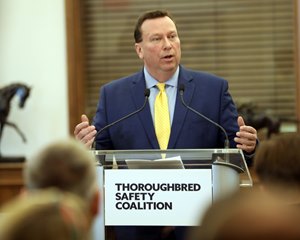NTRA, TOBA, Others Join Thoroughbred Safety Coalition


When the racetrack-led Thoroughbred Safety Coalition outlined its goals at a meeting last month at Keeneland, it invited other organizations with industry ties and similar goals to join its efforts.
The TSC reported Dec. 19 that its steering committee, which met in New York Dec. 18, approved four new coalition members: the National Thoroughbred Racing Association, Thoroughbred Owners and Breeders Association, Kentucky Thoroughbred Association, and the University of Kentucky.
NTRA president and CEO Alex Waldrop noted it had already approved a financial contribution to the TSC.
"On behalf of our broad-based membership, the NTRA board of directors in October unanimously voted to make a sizable contribution to the Thoroughbred Safety Coalition," Waldrop said. "We look forward to supporting the coalition's mission in any way we possibly can."
Other new members said they looked forward to working with the TSC to improve racing.
"Our passion for horses is at the forefront of our mission, and we are pleased to partner with the coalition in advancing the safety of equine athletes," TOBA president Dan Metzger said.
"The Kentucky Thoroughbred Association looks forward to collaborating with the coalition as we strive to do everything possible to ensure the safety and well-being of Thoroughbred horses and those who care for them," KTA executive director Chauncey Morris said.
"The University of Kentucky College of Agriculture, Food and Environment is proud to join the Thoroughbred Safety Coalition as the horse racing industry takes new steps to reconfirm its commitment to the safety of its equine and human athletes. We look forward to supporting the coalition's reform efforts with our ongoing research on safety, anchored by programs in drug testing and racetrack surfaces," said Nancy Cox, the dean of the college.
In a news release, the coalition welcomed the new members and noted that all organizations and individuals who are interested in joining the coalition's safety efforts are welcome and it looks forward to growing its membership in the coming weeks.
The TSC steering committee also discussed steps on advancing safety in Thoroughbred racing Wednesday.
The committee said the initial medication, organizational, and operational reforms unveiled last month continue to gain traction within the Thoroughbred racing community. According to the TSC release, members have been busy advocating for support and implementation at tracks—and with state regulatory bodies—throughout the country. One recent success includes last week's passage of enhanced safety and medication reforms by the Kentucky Horse Racing Commission after strong support from and ongoing dialogue with coalition members Churchill Downs Inc. and Keeneland Association Inc.
Leading Tracks Unite on Safety Through New Coalition
The release noted the steering committee reached a consensus to explore and implement additional safety measures to include the following:
- Data-driven decision-making: Coalition members will use advanced data collection and analysis to identify at-risk horses. These horses will receive added scrutiny before races, up to and including pre-race examinations performed by independent veterinarians.
- Use of diagnostic methodologies: The coalition will advocate for its members to use state-of-the-art diagnostic technology. Coalition member Santa Anita Park recently debuted a new PET scan machine to better diagnose ailments among its equine athletes. Other coalition members applaud Santa Anita for making this investment and agree incorporating preventative diagnostic testing into mainstream practices will help move the sport into the 21st century. In the future, data collected from PET scans and other methodologies will be utilized to help further identify at-risk horses.
- Extracorporeal shockwave therapy: As with any medical treatments, the use of this technique should have strict protocols. The coalition will draft and implement a policy that could mandate up to 30 days on the vet's list and require treatment to take place at a central location at each racetrack if this treatment is used.
- Minimum Thoroughbred workout standards: The coalition will expand the standards for minimum workout requirements to enable horses to be eligible to race. Though these standards are in place in some regions, such as California and New York, there is an opportunity to standardize and strengthen guidelines among a broader set of racetracks and jurisdictions.
- Increased licensing requirements for trainers: The coalition will work collectively and with other industry stakeholders to establish an enhanced proficiency standard for licensing to include continuing education for horsemen.
The TSC will continue to drive reforms across the Thoroughbred community to ensure the sport's athletes are participating under the safest conditions. The next steering committee meeting will be held at the end of January.
